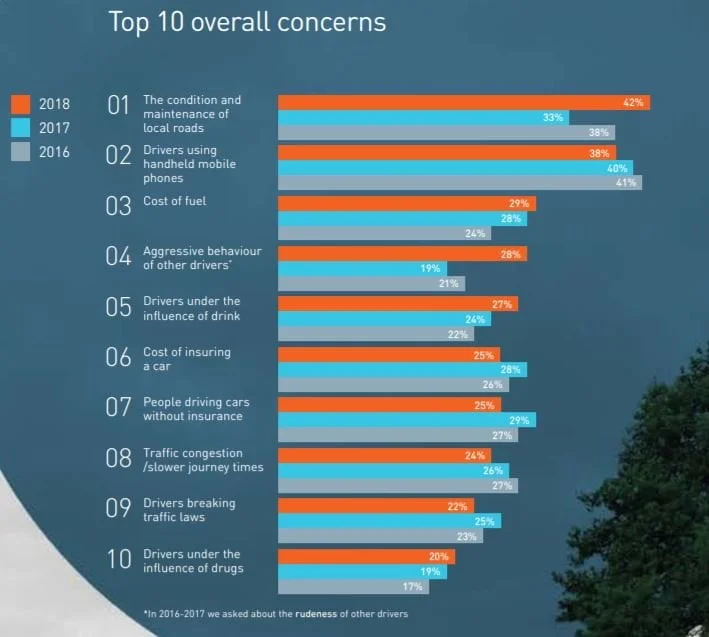RAC’s 30th Annual Report on Motoring
For the last 30 years, the RAC has canvassed the UK’s road users to asses their attitude and opinions on a range of topics. You can review the RAC’s digestible interactive overview (and download the full 50-page report) by following this link. If you are short on time read our article which summarises the main messages.
So what do the UK’s 40 million motorists have to say?
Top Concerns
The issue drivers are most concerned about is the condition of our roads. The large increase in the proportion of people concerned about road condition, compared to the previous year, would indicate that road maintenance is not keeping pace with road usage ( 27% of those asked said they were using their cars more than last year ) and adverse weather. Drivers want to see some of their road tax ring-fenced to ensure that roads are maintained to a sufficient standard.

Did you know that the NCAP car safety testing scheme was only established in 1997?
The second largest area of concern is drivers using hand held devices. Aggressive driving and drink driving are also of concern but strangely drug driving does not seem to worry most drivers and driving without insurance is also becoming less of a concern. Despite drink driving being a major concern the proportion of drivers admitting to driving over the limit is at one of its highest levels for several years. This could be due to the rising belief that motorists will not get caught by the police if they break the law.
Next Vehicle
Most of us (66%) admit to being confused about what our next car will be – we can’t decide if petrol, diesel or greener alternatives are best. This is not surprising given the drastic changes being made to public policy which don’t always appear to be logical.

Take diesel for instance. For years we were incentivised to buy diesel cars but in the past couple of years, it looks like diesel motorists will now be penalised. Old diesel engines undoubtedly belch out particulates that ruin air quality, however, this is not true of modern diesel engines. At the moment it doesn’t look like policy will differentiate between old and modern engine design. This lack of clarity is not helping the buying public, a whopping 68% of motorists are confused about the extent to which new diesel cars are polluting.
It was only in 2033 that the use of handheld devices while driving was banned which is the first year the London congestion charge was introduced.
Don’t forget the bold announcement made in 2017 by the government – petrol and diesel cars can’t be bought from 2040. Despite it being only 21 years away 49% of us can’t see ourselves buying an electric car within the next 15 years. Indications are that the high prices, limited range and the time taken to recharge electric cars are putting buyers off.
21 years does not seem like a long time for the technology to develop. However, it is incredible how much has been achieved in the last 21 years. It was only in 2011 that the first mass-produced electric car became available in the UK – the Nissan Leaf. In the same year, Toyota started to sell the Mirai which ran off a hydrogen engine which only produces water and heat as byproducts. In 2014 Tesla had refined the technology so much that they were able to produce a high-performance electric sports car. Now there are multiple options of hybrid or pure alternative energy cars. Prices are dropping and performance increasing all the time. Given teh pace of change over teh last 20 years we have reason to be hopeful that the technology will be there for the governments 2040 deadline.
Half of motorists plan to buy a petrol engine next with 1 in 5 opting for a diesel engine and around the same number will try a hybrid. See the image below for precise figures and comparisons with the previous year.
Public Transport
It is very interesting to look at the change in use of public transport between the first RAC survey, 30 years ago, and the latest one. Despite drivers reporting they are using their cars more – they also use public transport much more. Twice as many motorists use public transport as well as their carts now than 30 years ago. However 72% of motorists currently think that public transport needs to be improved substantially and quickly.
